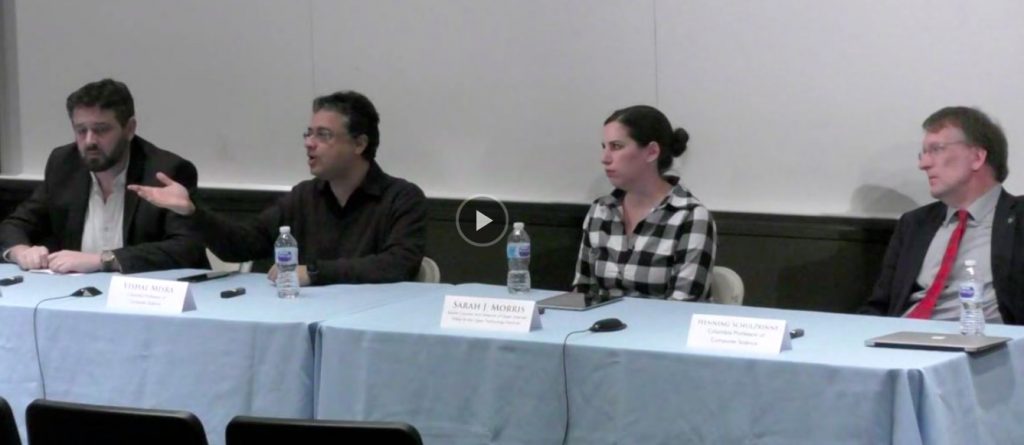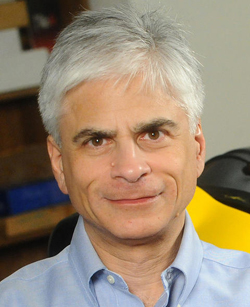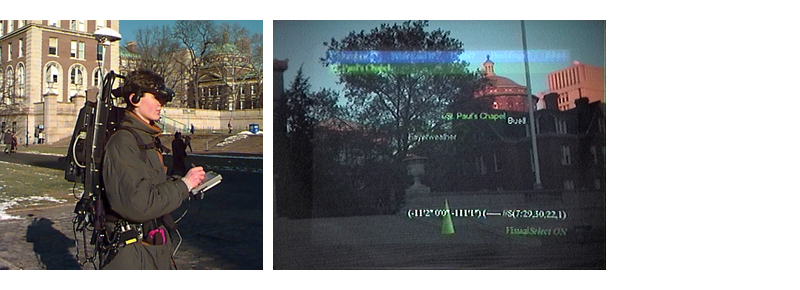Year: 2017
Panel on net neutrality discussed upcoming repeal of net neutrality rules
![]()
 Last Friday, with less than a week remaining before the FCC’s expected repeal of the Open Internet Rules, a panel of four experts convened before an audience in Davis Auditorium to discuss what such a repeal is likely to mean for the Internet. Though all four spoke from different perspectives—three were technology experts and one an Internet consumer advocate and lawyer—all expressed concerns about the repeal. (Though proponents of the repeal had been invited, none were able to attend.)
Last Friday, with less than a week remaining before the FCC’s expected repeal of the Open Internet Rules, a panel of four experts convened before an audience in Davis Auditorium to discuss what such a repeal is likely to mean for the Internet. Though all four spoke from different perspectives—three were technology experts and one an Internet consumer advocate and lawyer—all expressed concerns about the repeal. (Though proponents of the repeal had been invited, none were able to attend.)
The panel was moderated by Ethan Katz-Bassett, a professor of electrical engineering at Columbia, who is an expert on Internet services and content delivery, and by Brittney Gallagher, Digital Culture Correspondent for Digital Village, the oldest running radio program in Los Angeles that covers the Internet.
The discussion started with a rundown of the three bright lines that cannot be crossed under current rules—no throttling, no blocking, no paid prioritization. It is these rules (as well as other general-conduct rules) that, according to Sarah Morris ensure that Comcast doesn’t prioritize its streaming platform over Netflix or that a company can’t pay AT&T to favor its traffic over the traffic of a competitor.
While much attention has been focused on how the order will remove protections that prevent internet service providers (ISPs) like Comcast and Verizon from restricting or prioritizing traffic, Henning Schulzrinne, whose second term as CTO at the FCC just ended in October, pointed out the order also removes the FCC’s power to regulate Internet service, handing over this responsibility to the FTC. Given that the FTC has no authority to issue blanket rules to ban blocking or prevent other discriminatory practices, the US will effectively have no Internet regulation at all, a situation Schulzrinne calls unprecedented.
Another topic discussed was the lack of competition among the last-mile providers, that is, the ISPs that control the cables that run from the Internet’s main transit cables to smaller, neighborhood-scale cables that go to each individual house. Expensive as it is to lay these cables, no one was advocating for replicating last-mile cables, but under current conditions, the company that builds the last-mile cable controls access to customers.
Without competition and soon without any regulation, there is nothing to prevent AT&T, Verizon, or Comcast from monetizing their access to customers. In fact, in a market economy, there is every incentive to exploit one’s stranglehold on consumer eyeballs to extract access fees from content providers. While large rich companies like Amazon, Apple, Facebook, Microsoft, and Alphabet (Google)—the “frightful five”—can afford to pay for access to customers, many other companies cannot. It’s especially difficult for fledging startups and for not-for-profit sites and services.
For Vishal Misra, the solution is to switch from the “infrastructure-based competition” the US has currently to a model where service is based on competition between ISPs, with all ISPs having access to a common last mile everywhere and competing for customers by providing better services. It is a solution, however, that requires telecommunications oversight.
The potential downsides for innovation and new services of the FCC’s expected action was another of the topics covered. While FCC chairman Ajit Pai has argued that repeal of net neutrality is necessary for investments and to make the internet better through faster internet speeds, Peter Boothe said his analysis of M-Lab measurements over time suggests that Internet performance in the US improved at least as fast—and probably faster—since February 2015 (when the current regulations went into effect) than it was improving before the regulations.
The panel discussion in its entirety can be seen here.

Posted 12/11/2017
– Linda Crane
Steven Feiner and Salvatore Stolfo elevated to IEEE Fellow
![]() Two professors in the Computer Science Department at Columbia University have been named Fellows of the Institute of Electrical and Electronics Engineers (IEEE): Steven Feiner for “contributions to augmented reality and computer graphics,” and Salvatore Stolfo for “contributions to machine learning-based computer security.” IEEE is the world’s leading professional association for advancing technology for humanity, and the IEEE Fellow is the highest grade of IEEE membership, limited every year to one-tenth of one-percent of the total voting membership.
Two professors in the Computer Science Department at Columbia University have been named Fellows of the Institute of Electrical and Electronics Engineers (IEEE): Steven Feiner for “contributions to augmented reality and computer graphics,” and Salvatore Stolfo for “contributions to machine learning-based computer security.” IEEE is the world’s leading professional association for advancing technology for humanity, and the IEEE Fellow is the highest grade of IEEE membership, limited every year to one-tenth of one-percent of the total voting membership.

Steven Feiner is one of the earliest researchers to investigate and publish scholarly papers on augmented reality (AR), in which computer-generated media—text, graphics, video, sound—are integrated and geometrically aligned with a user’s experience of the real world, one example being by overlaying 3D virtual objects on what the user sees. Feiner joined the Columbia faculty in 1985 and started the Computer Graphics and User Interfaces Lab, addressing a broad range of topics in designing and interacting with synthesized pictures. Several years later, Feiner extended that work to virtual reality, in which virtual objects are viewed on their own, independent of the real world, and since 1990, he and his students have been investigating AR interaction and visualization techniques, and applications of AR to tasks such as equipment maintenance.
The lab’s first AR systems used a “see-through” head-worn display that Feiner and his students assembled to optically combine the real and virtual worlds, connected to desktop and deskside computers. Their earliest project augmented the user’s view of a small flat-panel display running a desktop window system by immersing it in a larger virtual environment, viewed through the head-worn display. The user could see the windows on the flat-panel display surrounded by the outlines of windows above, below, and to the sides of the flat panel. Feiner called this a “hybrid user interface” because it combined different display technologies in a way that benefited from their respective advantages.
The lab’s next project tracked in 3D selected parts of a laser printer, overlaying maintenance instructions directly on relevant parts as the user manipulated them. This posed questions central to the effective design of many kinds of AR experiences: What virtual content should be presented to help the user and what should be suppressed to avoid confusion? How should virtual content be positioned and sized relative to physical objects? How should rendering style be controlled to make content easy to understand? How should the user’s attention be directed toward content that was outside the field of view (e.g., to make the user move or turn to see it)? Feiner’s team developed rules that automatically designed and generated virtual content based on the task to be performed, the positions and orientations of the physical objects being manipulated, and the position and orientation of the user’s head.

Feiner soon decided that it was essential to explore how the lab’s AR systems could be made mobile and be taken outdoors. In 1996, Feiner and his students created the “Touring Machine,” which included a head-tracked, see-through, head-worn display, a hand-held tablet, and a backpack containing a computer and a very accurate kind of GPS. Both the backpack computer and tablet had digital radio modems for wireless access to the internet.
Before the era of smartphones, ubiquitous GPS, and Wi-Fi, and sixteen years before Google Glass in 2012, the Touring Machine allowed a user to walk around campus, be directed to a building or academic department of interest, view a building’s name and its department names overlaid on that building, and call up a department’s web page on the tablet.
Over time, the systems that Feiner and his lab built have become smaller and lighter weight, often being replaced with or built on top of purely commercial hardware and software. With support from NSF, ONR, and industry, the lab has had productive collaborations with colleagues in cognitive science, architecture, journalism, archaeology, and medicine from rehabilitation to surgery, investigating how to use augmented reality to assist users in performing many kinds of skilled tasks. Approaches designed for one person are complemented by ones that address multiple people, whether co-located or remote, and extended to asymmetric scenarios in which a remote expert working entirely in virtual reality can assist a local user performing a task in the real world guided by augmented reality. In most of the lab’s research, members create and refine new techniques, and evaluate them by designing, running, and analyzing user studies to compare those techniques with existing ones.
Feiner is coauthor of three textbooks, two editions of the well-known textbook Computer Graphics: Principles and Practice, as well as Introduction to Computer Graphics.
Being named an IEEE Fellow is his latest award. Just this fall, the paper introducing the Touring Machine received the Early Innovator Award from the International Symposium on Wearable Computers (ISWC), celebrating the paper from the first ISWC conference in 1997 that has had the most impact, and this year also Feiner received the Career Impact Award from the IEEE International Symposium on Mixed and Augmented Reality (ISMAR). Three years ago, Feiner received the IEEE VGTC 2014 Virtual Reality Career Award, and he was elected to the CHI Academy in 2011. Together with his students, he has won the ACM UIST 2010 Lasting Impact Award for early work on supporting 2D windows and hypermedia in augmented reality, and best paper awards at ACM UIST, ACM CHI, ACM VRST, IEEE ISMAR, and IEEE 3DUI.
“It is a great honor to be elevated to IEEE Fellow, and one that I owe in large part to the incredible students and colleagues with whom I have had the pleasure to work,” says Feiner. “It is fun to be in a field in which we must continually remind ourselves that the technologies we use now will, in just a few years, be eclipsed in power by ones that are a tiny fraction of the size and price. Our job is to understand how to use these ever more powerful tools to make the future a better place than the present for all of us.”
Steven Feiner did his undergraduate degree at Brown in 1973 and received his
PhD in Computer Science also from Brown in 1987

Computer security is not just about technology and systems. It is also about the people who use those systems and how their vulnerable behaviors can be exploited. That premise informs much of Salvatore Stolfo’s research into computer and network security. A Columbia professor since 1979, Stolfo starts with the assumption that data will always be a target. The only unknown is the specific path hackers will take to breach security.
One previously unforeseen path, exposed by Stolfo working with his student Ang Cui, is through embedded devices such as printers, routers, drones, webcams, medical devices, and the growing legions of IoT devices, very few of which come with built-in security. Stolfo and Cui made headlines by demonstrating that certain HP LaserJet printers would accept firmware updates without verifying their authenticity, allowing hackers to upload their own software to take over control of the printer. Later Stolfo and Ang would find serious vulnerabilities in Cisco’s VolP phones that could turn the phones into listening devices.
Stolfo did not start out concentrating in security. An early proponent of artificial intelligence and machine learning, Stolfo in the early 1980s developed a large-scale expert data analysis system, called ACE (Automated Cable Expertise) that was likely the first system to combine rule-based inference (an AI expert system) with a relational database management system; ACE was widely distributed to a telephone wire centers across the US. Stolfo also created machine learning algorithms to detect patterns of fraudulent credit card transactions, research that was adopted throughout the financial industry. Stolfo also co-developed the DADO computer system, a “fifth generation computer” sponsored by DARPA’s high performance parallel computing initiative. It was a fully functional 1023-processor for performing acoustic analyses and keyword spotting capabilities, and the parallel broadcast and resolve/report function that it introduced apparently influenced part of the design of the IBM Blue Gene parallel computer, is the basis of the Apache Hadoop MapReduce functionality for processing very large datasets.
DADO had one other distinction: it was the first invention claimed by Columbia University for ownership of a faculty member’s intellectual property under the Baye Dole Act. With outside investors, the technology was later commercialized and adapted for large-scale speech recognition services.
Combining research with entrepreneurship is a hallmark of Stolfo’s career. It’s a way of being able to experiment with new technology in a lab with students while being guided at the same time by practical, real-world concerns.
With funding from DARPA’s Cyber Panel program in the early 90s, Stolfo and his students began work on detecting network attacks and e-commerce fraud; it was the challenge of detecting the activities of creative but malicious fraudsters that Stolfo became hooked on security. In 1996 he established the Intrusion Detection System (IDS) lab at Columbia, which has received many millions of dollars in research funds. The lab would pioneer the use of data analysis and machine learning techniques for computer security and created the field of Adversarial Machine Learning. With support from DARPA and other federal agencies, Stolfo launched two start-ups to commercialize his research in the areas of active user authentication, deception security, and embedded systems security. Red Balloon Security commercialized the Symbiote technology for embedded systems and was named one of Popular Science’s Best of What’s New for 2016. Allure Security Technology has received millions of dollars in funding from the US government and private investors to innovate technology to stop data breaches.
To date, Stolfo has been granted over 73 patents and has published several books and well over 250 scientific papers on many diverse topics in computer science: parallel computing, AI knowledge-based systems, data mining, computer security and intrusion detection systems. Two of his security papers are among the top 20 most-cited security papers; several others have earned best paper awards, including the RAID Most Influential Paper and Usenix Security Distinguished Paper awards. His research has been supported by DARPA, NSF, ONR, and numerous companies and state and federal agencies.
“I’m truly honored to be elevated to IEEE Fellow,” says Stolfo. “My science has been driven by making an impact both inside and outside the academy, and I’ve had the good fortune to work alongside my colleagues and students towards that goal. I believe the internet should be secure for enterprises, and for everyday people in their everyday lives. I look forward to continuing my work to making the internet safe.”
Salvatore Stolfo received his Ph.D. from The Courant Institute of Mathematical Sciences,
New York University, in 1979.
Posted 12/7/2017
New media artist Amir Baradaran awarded two art grants to rethink storytelling and artistic authorship in an age of AR/AI

Amir Baradaran, an art-based researcher in Steven Feiner’s Computer Graphics and User Interfaces Lab (CGUI), has been awarded two grants totaling $220K to create two augmented reality installations, Facing the Cloud + (RE)storing Po{AI}try. Both will be created at Columbia within the CGUI lab.

A winner of the Canada Council for the Arts’ New Chapter Grant (for $120K) and a recipient of the Knight Arts Challenge (for $100K) from the prestigious John S. and James L. Knight Foundation, Baradaran has long been incorporating augmented reality (AR), artificial intelligence (AI), and other technologies into performance art pieces. Even while these technologies were in their early stages, Baradaran saw the potential in AR as a platform for creating immersive, participatory art, where audiences can augment or change an artist’s work.
AR’s implications for storytelling are explored in Facing the Cloud, where audience participants will don headsets to enter into a large-scale immersive installation. Through movements and gestures, they can interact and change the content of what the artist initially created.

“For over 100 years, cinema has conditioned audiences to passively observe a story told in linear time, with every scene tightly scripted and framed by the director and sometimes with input from the actors and other collaborators,” says Baradaran. “AR and AI fundamentally change this equation by allowing the audience to become a co-creator with the artist.”
How AR changes the relationship between art and artist doesn’t necessarily enter into the thinking of the computer scientists and programmers focused on technical aspects of AR. Says Feiner, a pioneer in developing AR technology, “Having Amir here in the lab provides a chance for cross-pollination with artists and others who bring different perspectives. We become better engineers when we’re more cognizant of how these technologies will change the way people interact with the world.”
Facing the Cloud was funded in part by the Knight Arts Challenge matching grant, which according to Victoria Rogers, VP of Arts at the Knight Foundation, “funds the best ideas for engaging and enriching Miami through the arts.” Facing the Cloud will be exhibited in late Spring 2018 in collaboration with the City of Miami’s Little Haiti Cultural Center and with the support of the Smithsonian Affiliate History Miami Museum and the Perez Art Museum Miami (PAMM).
The second project, (RE)storing Po{AI}try, is a large-scale public art project that examines the creative process of code-writing while critically exposing the notion of the presumptive neutrality of code. “Like poetry, code has syntax, symbols, punctuation, spacing, and words,” says Baradaran. “By conceptualizing the language of the machine—that is, code—as Po{AI}try, we can unsettle the disciplinary boundaries between the technologists and artists. Additionally, it helps us question the objective nature of programming as a neutral language. Like poets writing verse, engineers bring their own assumptions, value systems, and lived experiences when they write code.”
(RE)storing Po{AI}try is being funded by the Canada Council for the Arts’ New Chapter project, which was chosen for Canada’s 150th Anniversary Celebrations. Honoring the tradition of oral storytelling and its role in preserving diverse histories of Canada’s First Nations, Baradaran will collaborate with the Awkasasne Mohawk Community in Cornwall, Ontario. Canada
Po{AI}try will be installed at Montreal’s Place des Arts Complex in Fall 2018.
Both Facing the Cloud and (RE)storing Po{AI}try a critical story about the evolving role of augmented reality and artificial intelligence technology. “If AR is to become a new medium for artistic creation, it will require a set of visual and conceptual vocabularies along with technical toolsets for artists to design and implement within this new field,” says Baradaran. “Just as painters have tools like brushes and pigments to express ideas, artists working in AR/AI need theirs.” As the art-based researcher within Feiner’s lab, Baradaran is working directly with engineers and others to provide a common frame of reference and set of functionalities that artists and engineers can use to communicate and co-create.
“It’s really exciting to see the creativity of the arts in collaboration with the creativity of computer science here at Columbia,” says David K Park, Dean of Strategic Initiatives at Columbia University. “The excitement isn’t just about how these fields are working together to push, inform and illuminate the boundaries of virtual reality, AR, and AI as well as other technologies, but how the collaboration creates a richer conversation about how technology is shaping society and just as importantly how society is shaping technologies that we use. I know Amir’s project will engage a broad range of disciplines beyond just the arts and computer science and am excited to see what additional collaborations his work will spark here at Columbia.”
Baradaran is seeking further faculty and student collaborations in 2018. “We are looking for folks interested in mobile application development, Unity/game development, robotics, machine learning and natural language processing,” says Baradaran. He is reaching across campus to form partnerships with faculty members and their students in 2D-3D design, storytelling, journalism, architecture, film, animation, theater performance, acting, and sound production, as well as more theoretical fields such as (art) history, policy, law, and communications.
Those interested interested in learning more can contact amir.baradaran@columbia.edu.
Posted 12/08/17
Steven Bellovin among those calling for government agency to investigate cybersecurity incidents
Modeled on the Aviation Safety Reporting System, such an agency would investigate major cyberattacks and “near misses,” publishing results so others could better understand—and avoid—the threats. Reporting would be voluntary, anonymous, and nonpunitive.
Why W1004? The Lowdown on Professor Cannon’s Introduction to Computer Science and Programming in Java
Columbia Spectator gives Adam Cannon high marks for his humor, direct interaction with students, easygoing demeanor, and, most importantly, for making computer science make sense.
First “Frontiers in Robotics” Conference Highlights Columbia Research and Innovation
Peter Allen and Matei Ciocarlie were among the robotics researchers making presentations. Held October 19, the event was attended by academics and executives from venture capital firms and technology companies.
New software can verify someone’s identity by their DNA in minutes
Paper published in eLife describes a method for using $1000 DNA sequencers to quickly and accurately identify cells lines from DNA. Lead author Yaniv Erlich sees a huge potential to improve cell-authentication in cancer research.
Steven Feiner receives a Career Impact Award from IEEE ISMAR
![]()

This year’s IEEE International Symposium on Mixed and Augmented Reality (ISMAR) recognized Steven Feiner with the Career Impact Award for “significant impact over his career to the ISMAR community.” ISMAR is the premier international conference for research in mixed and augmented reality.
A Professor of Computer Science at Columbia University, Feiner has been working in the field of augmented reality for more than 25 years and published some of the earliest scholarly papers on the subject.
At Columbia he directs the Computer Graphics and User Interfaces Lab, which in 1996 created the first outdoor mobile augmented reality system using a see-through display, paving the way for current smartphone outdoor augmented reality applications; the paper describing the system received the Early Innovator Award from the International Symposium on Wearable Computers (ISWC) just this year. His lab also pioneered experimental applications of augmented reality in tourism, journalism, maintenance, construction, and other fields.

Beyond augmented reality, Feiner’s research interests extend to human-computer interaction, 3D user interfaces, virtual environments, knowledge-based design of graphics and multimedia, mobile and wearable computing, computer games, healthcare, information visualization, and he co-directs the Columbia Vision and Graphics Center.
Feiner is coauthor of three textbooks, two editions of the well-known textbook Computer Graphics: Principles and Practice (the two editions were written twenty years apart and with different authors) as well as Introduction to Computer Graphics.
Among his awards, Feiner is a recipient of the IEEE VGTC 2014 Virtual Reality Career Award, and he was elected to the SIGCHI Academy (2011). Together with his students, he has won the ACM UIST 2010 Lasting Impact Award for early work on supporting 2D windows in augmented reality, and best paper awards at ACM UIST, ACM CHI, ACM VRST, IEEE ISMAR, and IEEE 3DUI.
Throughout the years, he has served as general chair (or cochair) and program chair (or cochair) for the premier research conferences in augmented reality and virtual reality: both ISMR and IEEE ISAR (the forerunners of IEEE ISMAR), IEEE VR, and ACM VRST, along with the leading research conference on innovations in human-computer interfaces, ACM UIST.
Feiner did his undergraduate degree at Brown in 1973 and received his PhD in Computer Science also from Brown in 1987
Posted 11/28/17
Steven Bellovin among 54 tech experts raising concerns about using AI for extreme vetting
Writing to the Department of Homeland Security, 54 computer scientists and academic researchers criticized a proposed plan to use AI methods to screen immigrants and visa applicants. In this interview, Bellovin specifies some technology concerns.

